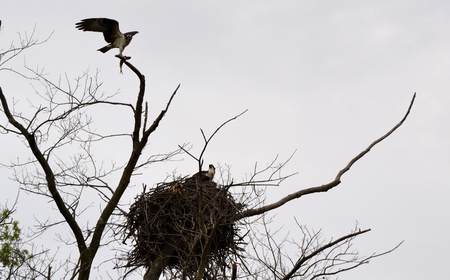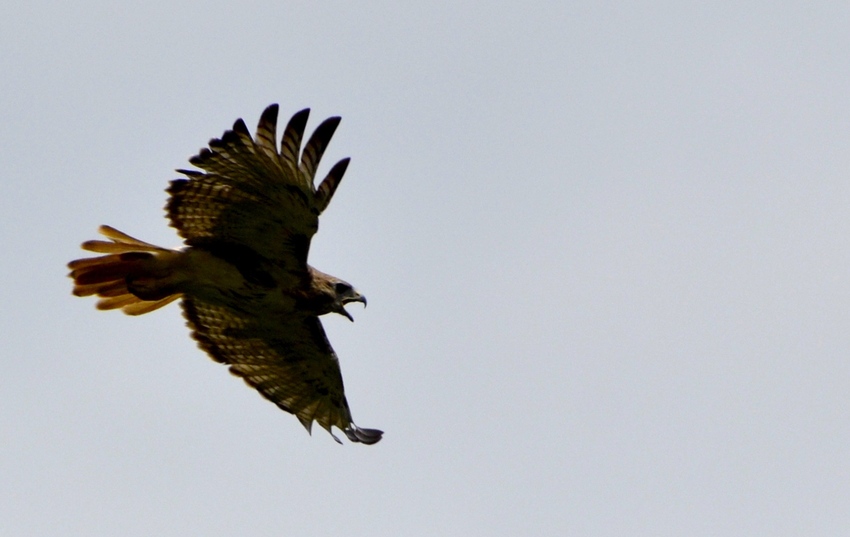It’s not every day someone is dive-bombed by a speeding red-tailed hawk.
The bird of prey, a common sight around Virginia with its recognizable broad wingspan and fierce gaze, has a grip strength of 250 pounds per square inch—enough to crush bones in the human hand.
Longwood student researcher Russell Reed, however, was eyewitness to a relatively rare attack on a research trip to Hull Springs Farm. Reed was at the 662-acre farm in Westmoreland County that is operated by Longwood to observe birds of prey for an ongoing research project. His friend was photographing the hawk’s nest, which was about 65 feet up in a pine tree.
From the hawk’s perspective, she got too close.
"I heard my friend yelling, then saw the red-tail circle pretty close and dive at her, getting as close as 5 or 6 yards. She dropped her camera and ran," said Reed ’16, an anthropology major from Mathews County. "Fortunately, the hawk didn’t pursue her when she ran away. It was probably a warning rather than an attack. Still, she was shaken up."
Reed hasn’t been "dive-bombed" in his research, though he did have an uncomfortable encounter with an osprey while kayaking on the nearby Machodoc River this July. "The osprey circled low and close behind me," he said. "She turned at me but never did dive. I paddled away and tried to make sure I kept looking behind me. I was worried she might attack me in the back of my head."
In the independent research project, which Reed custom designed to fulfill his environmental studies minor, he surveyed the osprey population at Hull Springs Farm and monitored their interactions with bald eagles during summer 2014. This summer he revisited the osprey survey and also monitored their interactions with red-tailed hawks.
Hull Springs Farm has been ideal for Reed’s research. Known for its pristine condition and diverse wildlife habitats, the Westmoreland County farm is used for education and research—essentially, it’s an outdoor classroom.
"Hull Springs Farm is an amazing, unique place to view wildlife, one of the best places in Virginia," said Reed, who plans to be a game warden. "On previous visits, I had noticed that there was a high density of raptors, and that the nests of three different species were in proximity to each other. This research was an opportunity that was rare and convenient."
Reed has always been fascinated by birds of prey, also known as raptors, which are characterized by what he called their "keen eyesight, strong hooked beaks and sharp talons." He is especially fond of ospreys and red-tailed hawks.
"Raptors exhibit a lot of ‘wow’ factors," said Reed. "Red-tailed hawks, for example, can accurately hit a target in a dive in which, before hitting the brakes, they attain a speed of up to 120 miles per hour. Raptors see farther and faster than humans; they see in more frames per second than we do.
"Ospreys are phenomenal catchers of fish. Due to the shape of their wings and tail—long and thin—they’re good at diving. And because their feathers are water-repellent, they can plunge under the water to catch a fish and fly away. A bald eagle cannot do that; their feathers fill up with water, so they have to swim to shore, or they drown. Thus, when they’re catching fish, they’re limited to what they can grab from the surface of the water.
"On each foot, the osprey has three toes in front and one in back, but the outside toe in the front is double-jointed, so they can hold a fish aerodynamically—face first and tail last—making it easier to fly with and control. They can rotate that toe so it’s like a back toe, like they have two in front and two in back, giving them an even grip. They’re perfectly designed for what they do, just like red-tailed hawks who soar a lot when hunting and whose wings and tail are bigger and broader than those of ospreys."
Much of Reed’s research has involved observing osprey nests, which he said are always on or very near water. "Ospreys are linked to water; they need water and a source of fish to survive," he said. He surveyed 52 active osprey nests at Hull Springs Farm last summer—each nest has an adult male and an adult female—and 56 nests this summer.
"Only four or five of these nests are in trees. Most are in boxes on posts, on people’s docks, on boats or on channel markers," said Reed. "They’ll nest in any stable platform on a waterway. It’s much more difficult to find red-tailed hawks’ or bald eagles’ nests because they’re more secretive and their nests are more secluded."

Reed also has observed interactions among the three species. "Ospreys and bald eagles do not get along—they fight, raid each other’s nests and, if given the chance, will kill each other. The same is true of bald eagles and red-tailed hawks. On the other hand, there is no adversarial relationship between red-tailed hawks and ospreys. They can sit on the same branch and not pay each other any mind."
One day, Reed, sitting on a dock 15-20 yards away, spent 12 hours observing an osprey nest near the camphouse, which is used often for overnight accommodations for students. Another day, he kayaked "without stopping" from 7:45 a.m. to 8:15 p.m. to mark all of the osprey nests on the Machodoc River. "That was definitely a long day," he said.
Reed finished his fieldwork in late July and hopes by mid-September to produce an online, interactive Geographic Information Systems map of all of Hull Springs Farm’s osprey nests, which he has GPS-marked. The map will include descriptions, audio and photographs.
The six-credit project has been supervised by Dr. Mark Fink, associate professor of biology and chair of the Department of Biological and Environmental Sciences. "I’m impressed by Russell’s determination and by his inquisitiveness about the natural world," said Fink. "His work provides important baseline data on population size and density of osprey and bald eagles in the Hull Springs Farm vicinity, and I am looking forward to seeing his finished work which will provide a great resource for future studies at Hull Springs."
Reed, who plans to incorporate educational programs on birds of prey into his career, called the project "a great opportunity to get a glimpse" of his future work. "I’m grateful to Longwood, Dr. Fink and Hull Springs Farm for the opportunity to design my own research project, which is pretty rare," he said.



Leave a Comment